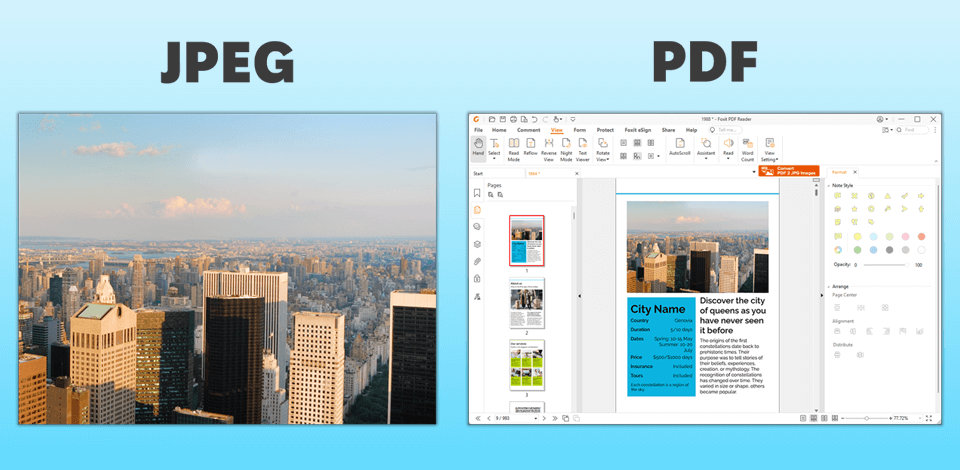

JPEG is one of the most well-known image formats. It's a perfect option for pics with gradients, but there have been complaints about loss of detail.
JPEG uses lossy compression that decreases file sizes by discarding some of the less important info in an image. Virtually all devices and apps support this format.
Key Features:

PDF format developed by Adobe company for document sharing, but in fact, it is more versatile. Unlike JPEG, PDF functionality goes beyond images and also includes text, vector graphics, and interactive elements.
Moreover, PDFs preserve formatting across various platforms and devices, making them perfect for document sharing.
Key Features:
When working with pics and docs, selecting the right file format is crucial, as it defines quality and usability. To help you choose the most suitable format for your needs, I’ve compiled this handy table that contains key features and differences.
| JPEG | ||
|---|---|---|
|
Compression
|
Lossy |
Lossy and Lossless
|
|
Quality
|
Can become worse with high compression |
Preserves high quality |
|
File Size
|
Generally small
|
Generally small |
|
Color Depth
|
24-bit color (16.7 million colors)
|
Works with various color models |
|
Transparency |
No |
Yes (in images and vector graphics) |
|
Use Cases
|
Photographs, web images |
Documents, e-books, forms |
People often search for JPEG vs PDF comparisons and try to figure out which format is most suitable for their needs like scanning, printing, displaying online, etc. Each file type has its specific features and strengths. To make the right choice, define the intended use like storing pics, sharing docs, or achieving flawless compatibility across different devices. Knowing how these formats are different from each other is crucial for deciding on the suitable option for your projects.
JPEG format is perfect for professionals and non-professionals who deal with photos, web images, or any graphics, where the size of the file and loading time really matter. This format is widely applicable in digital photography, social media, and websites. In contrast, PDF is preferable for users who need to distribute complex docs like reports, e-books, forms, or presentations. It can also come in handy to retain consistency in formatting and quality across different platforms and devices.
As JPEG is known for its smaller file size, it is a go-to option for publishing on the web. The files in this format load faster and consume less bandwidth, which is really great. Whether you need pics for publishing on websites, social media platforms, or online photo galleries, JPEG images will work well. As PDF is designed to maintain quality, this file type is not optimized for web use. The major problems are considerable file size and frequent compatibility issues with online platforms.
PDF is the best image format for printing. Not only does it work with different color models and printing standards, but also ensures a high quality of pics and text. JPEG is also suitable for printing, but when zoomed the level of detail and quality are likely to degrade.
Yes, you can edit JPEG files, but repeated saving means a higher level of compression, so the quality of pics can worsen. When editing JPEG, you deal with pixels, meaning that some changes will cause quality loss. The major plus of PDF files is the ability to edit text and graphics without affecting the quality. To customize a PDF file, use such tools as Adobe Acrobat.
As for JPEG, an editor cannot make this file type transparent. On the other hand, PDFs support transparency in pics and vector graphics, which is an essential feature for complex design projects and layered content.